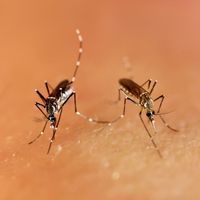mosquitoes

Amanda Tokash-Peters Links the Microbiome to Ecology
Shawna Williams | May 1, 2021 | 3 min read
The Centenary University professor studies the far-reaching effects of changes in the gut bacteria of mosquitos and other species.

Disease-Carrying Mosquito Species Returns to Florida
Shawna Williams | Mar 17, 2021 | 2 min read
Aedes scapularis is already established on the peninsula, and researchers predict that its population will continue to spread.

Insects Pass Antiviral Immunity to Offspring
Abby Olena, PhD | Dec 17, 2020 | 4 min read
In both Drosophila and mosquitoes, protection lasts for generations following a single maternal exposure to positive-sense single-stranded RNA viruses.

Mosquitos in Asia and the Americas More Susceptible to Zika Virus
Abby Olena, PhD | Nov 19, 2020 | 4 min read
A study explains how Zika was present among mosquitoes in Africa for decades without causing the harm to human health seen outside the continent in recent years.

Bacteria-Laced Mosquitoes Limit Spread of Dengue
Amanda Heidt | Aug 28, 2020 | 4 min read
Cases of dengue were greatly reduced in areas of a city where Wolbachia-infected mosquitos were released, according to preliminary data from a field study.

750 Million GM Mosquitoes Will Be Released in the Florida Keys
Lisa Winter | Aug 21, 2020 | 2 min read
There have been no reports of health or environmental harm in other locations where genetically modified mosquitoes have been introduced over the last decade.

How the COVID-19 Pandemic Has Affected Field Research
Ashley Yeager | Aug 20, 2020 | 6 min read
Unable to travel to international or remote sites, some researchers are losing critical data.

Insects Showcase Unexpected Ways to Make Water-Repellent Surfaces
Viviane Callier | Jul 17, 2020 | 4 min read
The intersection between water, air, and insects’ intricately decorated surfaces turn out to be the key to explain why droplets bounce so quickly off of them.

Dengue Cases Drop After Bacteria-Infected Mosquitoes Released
Emily Makowski | Nov 22, 2019 | 2 min read
Aedes aegypti infected with Wolbachia—which inhibit transmission of the dengue virus from insect to human—were deployed in Indonesia, Vietnam, Brazil, and Australia.

GM Mosquito Progeny Not Dying in Brazil: Study
Kerry Grens | Sep 17, 2019 | 2 min read
The biotech Oxitec had released the genetically engineered insects with the hope that they would breed with wild populations and produce offspring that die young. But that’s not always happening.

Image of the Day: Mosquito Flight Simulator
Nicoletta Lanese | Jul 30, 2019 | 1 min read
Carbon dioxide pumped into a bright chamber mimics a breathing host for the pest to target.

Combination Strategy Nearly Eliminates Invasive Mosquitoes in Field
Abby Olena, PhD | Jul 17, 2019 | 3 min read
Researchers use two techniques—Wolbachia infection and irradiation—to suppress reproduction in populations of Asian tiger mosquitoes at two study sites in China.

Allele Shows Pyrethroid Resistance’s Spread in African Mosquitos
Carolyn Wilke | Mar 22, 2019 | 4 min read
Researchers can now track the expansion of a resistance mechanism that allows the malaria vector Anopholes funestus to detoxify a key insecticide used on bed nets.

Emily Derbyshire Looks for Malaria’s Vulnerabilities
Shawna Williams | Mar 1, 2019 | 3 min read
The Duke University professor studies the parasite to find a way to thwart infection before it takes hold.

Infographic: Fighting Malaria Drug Resistance
Natalie Slivinski | Mar 1, 2019 | 2 min read
The parasite that causes malaria has evolved to evade many of the drugs that researchers have developed to fight the tropical disease.

Deforestation Tied to Changes in Disease Dynamics
Katarina Zimmer | Jan 29, 2019 | 8 min read
Numerous studies link habitat destruction to malaria and other vector-borne diseases, but the relationship isn’t always clear.

Photos of the Year
Carolyn Wilke | Dec 21, 2018 | 2 min read
From 500-million-year-old fat to a newly discovered virus, here are some stunners from The Scientist in 2018.

No Ban on Gene Drives: UN Convention
Kerry Grens | Nov 30, 2018 | 1 min read
United Nations members agree to some restrictions on the technology, but not a total suspension of its use.

Image of the Day: Swish Swish
Kerry Grens | Oct 16, 2018 | 1 min read
Animals’ tails swat away insects using both wind and whack.

Ibuprofen’s Effects Found in Offspring of Exposed Mosquitoes
Carolyn Wilke | Oct 1, 2018 | 2 min read
Results of a study suggest that toxicologists should look further than exposed individuals for contaminant effects.
